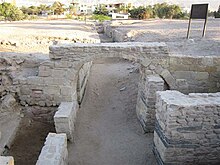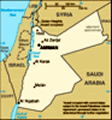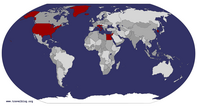Advertisement
Published: March 12th 2020
Today we had a beautiful sunrise at the peaceful Bedouin camp. We left at 7 a.m. and went by 4 X4 to Sammy's camp for breakfast. After breakfast we traveled to Aqaba - a port city on the Red Sea. This city was a strategic city in WW1 with Lawrence of Arabia.
Aqaba (English:
/ˈækəbə/,
also
US:
/ˈɑːk-/;
Arabic: العقبة,
romanized: al-ʿAqaba, al-ʿAgaba, pronounced
) is the only coastal city in
Jordan and the largest and most populous city on the
Gulf of Aqaba.
Situated in southernmost Jordan, Aqaba is the administrative centre of the
Aqaba Governorate.
The city had a population of 148,398 in 2015 and a land area of 375 square kilometres (144.8 sq mi).
Today, Aqaba plays a major role in the development of the
Jordanian economy, through the vibrant trade and tourism sectors. The
Port of Aqaba also serves other countries in the region.
Aqaba's strategic location at the northeastern tip of the
Red Sea between the continents of Asia and Africa, has made its port important over the course of thousands of years.
The ancient city was called
Elath, adopted in Latin as
Aela and in Arabic as
Ayla. Its strategic location and proximity to copper mines made it a regional hub for copper production and trade in the
Chalcolithic period.
Aela became a bishopric under
Byzantine rule and later became a Latin Catholic
titular see after
Islamic conquest around AD 650, when it became known as
Ayla; the name
Aqaba is late medieval.
The
Great Arab Revolt's
Battle of Aqaba, depicted in the film
Lawrence of Arabia,
resulted in victory for Arab forces over the
Ottoman defenders.
Aqaba's location next to
Wadi Rum and
Petra has placed it in Jordan's golden triangle of tourism, which strengthened the city's location on the world map and made it one of the major tourist attractions in Jordan.
The city is administered by the
Aqaba Special Economic Zone Authority, which has turned Aqaba into a low-tax, duty-free city, attracting several mega projects like
Ayla Oasis,
Saraya Aqaba,
Marsa Zayed and expansion of the Port of Aqaba.
They are expected to turn the city into a major tourism hub in the region.
However, industrial and commercial activities remain important, due to the strategic location of the city as the country's only
seaport. The
Edomites, who ruled over
Edom just south of the
Dead Sea, are believed to have built the first port in Aqaba called
Elath around 1500 BC, turning it into a major hub for the trade of copper as the
Phoenicians helped them develop their maritime economy. They profited from its strategic location at the junction of trading routes between Asia and Africa.
Around 735 BC, the city was conquered by the
Assyrian empire. Because of the wars the Assyrian empire had in the east, its trading routes were diverted to the city and the port witnessed relative prosperity. The
Babylonians conquered it in 600 BC. During this time, Elath witnessed great economic growth, which is attributed to the business background of its rulers who realized how important the city's location was. The
Persian Empire took the city in 539 BC.
 Roman
Roman milestone that marked the starting point of the
Via Nova Traiana on display in the
Aqaba Archaeological Museum.
 Aqaba Church
Aqaba Church, considered to be the world's first purpose-built church.
The city continued to grow and prosper which made it a major trading hub by the time of the
Greek rule by 300 BC, it was described by a Greek historian to be "one
of the most important trading cities in the Arab World".
The
Ptolemaic Greeks called it
Berenice.
The
Nabatean kingdom had a large population north of the city, the ones who had built
Al-Khazneh in the city of
Petra, they outnumbered the Greeks which made the capture of the city easy.
One of the oldest known texts in
Arabic alphabet is an inscription found in
Jabal Ram 50 kilometres (31 miles) east of Aqaba.
In 64 BC following the
Roman conquest, they annexed the city and called it
Aela (also
Haila,
Aelana, in Greek rendered Άιλα
Aila).
Both Petra and Aela were under strong
Nabatean influence despite Roman rule. Aela reached its peak during Roman times, the great long distance road the
Via Traiana Nova led south from
Bostra through
Amman, terminating in Aela, where it connected with a west road leading to
Philistia and
Egypt. Around AD 106 Aela was one of the main ports for the Romans.
It was the home origin of what came to be known as the
Ayla-Axum Amphoras. By the time of
Eusebius, Aela became the garrison of the
Legio X Fretensis, which was
moved to Aela from Jerusalem.
Aela came under
Byzantine Empire rule in AD 300, where the
Aqaba Church was constructed, considered to be the world's very first purpose-built church.
The city became a
Christian bishopric at an early stage. Its bishop Peter was present at the
First Council of Nicaea,
the first
ecumenical council, in 325. Beryllus was at the
Council of Chalcedon in 451, and Paul at the synod called by
Patriarch Peter of Jerusalem in 536 against
Patriarch Anthimus I of Alexandria, a council attended by bishops of the Late
Roman provinces of
Palaestina Prima,
Palaestina Secunda and
Palaestina Tertia, to the last-named of which Aela belonged.
Aila fell to the
Islamic conquest by 650, and the ancient settlement was left to decay, while a new Arab city was established outside its walls under
Uthman ibn Affan.,
also known as
Ayla (
Arabic: آيلة). The geographer
Shams Eddin Muqaddasi describes Ayla as nearby the ruined ancient city.

A view of Ayla

Ayla with a background view of mountains North of Aqaba
 Aqaba Fortress
Aqaba Fortress The city prospered from 661 to 750 under the
Ummayads and beyond under
the
Abbasids (750–970) and the
Fatimids (970–1116). Ayla took advantage of its key position as an important step on the road to
India and Arab spices (frankincense, myrrh), between the
Mediterranean Sea and the
Arabian Peninsula. The city is also mentioned in several stories of the
Arabian Nights.
Baldwin I of Jerusalem took over the city in 1116 without much resistance. The center of the city then moved to 500 meters along the coast to the south, and the crusader fortress of
Helim was built, as well as
Pharaoh's Island (now in
Egyptian territorial waters about 7 kilometres (4 miles) west of Aqaba). The city declined in the late 12th century due earthquakes and attacks by
Bedouins and Mamluks forces.
Ayla remained under the control of the
kingdom of Jerusalem from 1116 until 1187, when it was captured by
Saladin. The settlement by this point had essentially disappeared, and the site became known after the nearby mountain-pass, as
al-ʿAqaba. The old fort was rebuilt, as
Aqaba Fortress, by sultan
Al-Ashraf Qansuh Al-Ghuri in the early 16th century. For the next four centuries, the site was a simple fishing village of little importance.
During World War I, the Ottoman forces were forced to withdraw from
Aqaba in 1917 after the
Battle of Aqaba, led by
T. E. Lawrence and the Arab forces of
Auda abu Tayi and
Sherif Nasir. The capture of Aqaba allowed the British to supply the Arab forces.
In 1918, the regions of Aqaba and Ma'an were officially incorporated into the
Kingdom of the Hejaz. In 1925,
Ibn Saud the ruler of
Nejd with the help of his Wahhabi
Ikhwan troops successfully annexed the Hejaz, but gave up the Ma'an and Aqaba to the British
protectorate of
Transjordan.
In 1965,
King Hussein, through an exchange deal with
Saudi Arabia, gave 6,000 square kilometres (2,317 square miles) of desert-land in Jordanian territories in exchange for other territories, including 12 kilometres (7 miles) of an extension of prime coastline south of Aqaba, which included the magnificent Yamanieh
coral reef.
Aqaba was a major site for imports of
Iraqi goods in the 1980s until the
Persian Gulf War.
We had a boat ride/snorkeling trip to the coral reef. I don't have an underwater case so I didn't take photos underwater. The corals and fish were beautiful. The water was cold (19-20 Celsius) but it was worth it. After snorkeling we had lunch and then danced on the boat on the way back
to port.
I spent several hours trying to rebook my flight, then we walked nearby the hotel and had dinner. There are many hotels and restaurants in walking distance of where we are staying, so some of us went to a Syrian restaurant. I had yogurt/cucumber appetizer and kebab Aleppo style. I've been really impressed with the food on this trip - both in Egypt and Jordan.
Talal, our leader, has talked about Hand motions (significant so you don't do the wrong one), was to tie the scarf, political situation and the royal family, and many other things. All the information is a bit overwhelming which is why I use wikipedia for the places we are visiting.
The scarf: The
keffiyeh or
kufiya (
Arabic: كُوفِيَّة
kūfiyyah, meaning "from the city of
Kufa"
(الْكُوفَة); plural كُوفِيَّات
kūfiyyāt), also known as a
ghutrah (غُترَة),
shemagh (شُمَاغ
šumāġ),
ḥaṭṭah (حَطَّة),
mashadah (مَشَدَة),
chafiye,
dastmal yazdi (
Persian: دستمال یزدی,
Kurdish: دەستمال یەزدی
destmal yezdî) or
cemedanî (
Kurdish: جەمەدانی), is a traditional
Arabian headdress, or what is sometimes called a habit, that originated in the
Arabian Peninsula, and is
now worn throughout the
Middle-East region. It is fashioned from a square
scarf, and is usually made of
cotton.
The Keffiyeh is commonly found in
arid regions, as it provides protection from
sunburn, dust and sand.
In
Jordan, the red-and-white keffiyeh is strongly associated with the country and its heritage, because the red color was introduced into the Keffiyeh by the Jordanian Bedouins under British rule , where it is known as the
shemagh mhadab. The Jordanian keffiyeh has decorative cotton or wool tassels on the sides; the bigger these tassels, the greater the garment's supposed value and the status of the person wearing it. It has long been worn by
Bedouins and villagers and used as a symbol of honor and/or
tribal identification. The tasseled red-and-white Jordanian
shemagh is much thicker than the untasseled red-and-white shemagh seen in Persian Gulf countries.
Gestures and body language
There’s a whole range of gestures used in Arab culture which will either be new to you or which carry different meanings from the same gesture in your home country. Rather than nodding, yes is indicated by inclining your head forwards and closing your eyes. No is raising your
eyebrows and tilting your head up and back, often accompanied by a little “tsk” noise (which doesn’t indicate impatience or displeasure). Shaking your head from side to side means I don’t understand. A very useful gesture, which can be used a hundred times a day in all kinds of situations, is putting your right hand over your heart: this indicates genuineness or sincerity, and can soften a “no thanks” to a street-seller or a “sorry” to a beggar, or reinforce a “thank you very much” to someone who’s helped you. Many people in the south of Jordan will instinctively touch their right hand to their heart after shaking hands.
One hand held out with the palm upturned and all five fingertips pressed means wait. A side-to-side wrist-pivot of one hand at chest level, palm up with the fingers curled, means what do you want? If someone holds their flat palm out to you and draws a line across it with the index finger of the other hand, they’re asking you for whatever document seems relevant at the time – usually a passport. You can make the same gesture to ask for the bill (check) in a restaurant.
Pointing
at someone or something directly with your index finger, as you might do at home, in Jordan casts the evil eye; instead you should gesture imprecisely with two fingers, or just flap your whole hand in the direction you mean. Beckoning with your palm up has cutesy and overtly sexual connotations; instead you should beckon with your palm facing the ground and all four fingers together making broom-sweeping motions towards yourself.
The Royal Family:
Hussein bin Talal (
Arabic: الحسين بن طلال,
Al-Ḥusayn ibn Ṭalāl; 14 November 1935 – 7 February 1999) reigned as
King of Jordan from 11 August 1952 until his death in 1999. According to Hussein, he was a
40th-generation direct descendant of
Muhammad as he belonged to the
Hashemite family which has ruled Jordan since 1921.
Hussein was born in
Amman as the eldest child of
Talal bin Abdullah and
Zein Al-Sharaf. Hussein began his schooling in Amman, continuing his education abroad. After Talal became King of Jordan in 1951, Hussein was named
heir apparent. The
Parliament forced Talal to
abdicate a year later due to his illness, and a
regency council was appointed until Hussein came of age. He was enthroned at the age of 17 on 2 May 1953. Hussein was
married four separate times and fathered eleven children:
Princess Alia from
Dina bint Abdul-Hamid;
Abdullah II,
Prince Faisal,
Princess Aisha, and
Princess Zein from
Antoinette Gardiner;
Princess Haya and
Prince Ali from
Alia Touqan;
Prince Hamzah,
Prince Hashim,
Princess Iman, and
Princess Raiyah from
Lisa Halaby.
Abdullah II bin Al-Hussein (
Arabic: عبدالله الثاني بن الحسين,
ʿAbdullah al-thani bin Al-Husayn, born 30 January 1962) has been
King of
Jordan since 1999. He belongs to the
Hashemite family, who have ruled Jordan since 1921 and claim
agnatic descent from
Muhammad's daughter
Fatimah.
Abdullah was born in
Amman as the first child of
King Hussein and his second wife, British-born
Princess Muna. As the King's eldest son, Abdullah was heir apparent until Hussein transferred the title to Abdullah's uncle,
Prince Hassan, in 1965. Abdullah began his schooling in Amman, continuing his education abroad. He began his military career in 1980 as a training officer in the
Jordanian Armed Forces, later assuming command of the country's
Special Forces in 1994, and he became a major general in 1998. In 1993 Abdullah married
Rania Al-Yassin (of Palestinian descent), and they have four children:
Crown Prince Hussein,
Princess Iman,
Princess Salma and
Prince Hashem. A few weeks before his death in 1999, Hussein named Abdullah his heir, and Abdullah succeeded his father.
Advertisement
Tot: 0.136s; Tpl: 0.021s; cc: 11; qc: 28; dbt: 0.0301s; 1; m:domysql w:travelblog (10.17.0.13); sld: 1;
; mem: 1.2mb














 Maroon
Maroon 










